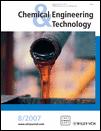Aggregation Experiments on Fine Fly Ash Particles in a Gradient Magnetic Field
Abstract
Aggregation experiments were conducted on two kinds of fly ash particles in the size range of 0.023–9.314 μm in a gradient magnetic field produced by permanent magnetic rings. The two types of fly ash particles were obtained from Dongsheng and Datong coal combustion. The effect of particle size, total particle mass concentration, particle residence time in the magnetic field and gas velocity were examined. Experimental results showed that the removal efficiencies in a gradient magnetic field are much higher than those in a uniform magnetic field. The total and single-sized particle removal efficiencies can be improved by increasing the total particle mass concentrations and the particle residence time in the magnetic field or reducing the gas velocity. Mid-sized particle removal efficiencies are higher than those of the larger and smaller ones. With the increase in total particle removal efficiencies, the particle size corresponding to the maximum values of single-sized particle removal efficiencies and the particle number median diameters both decrease. Both the single-sized and total removal efficiencies for the particles from the Dongsheng coal combustion are higher than those from the Datong coal combustion.




